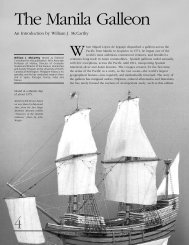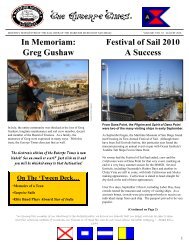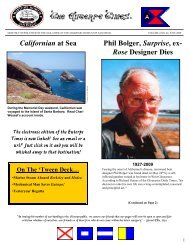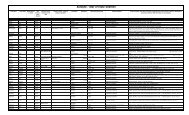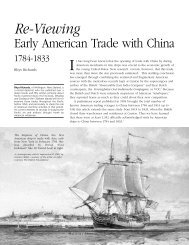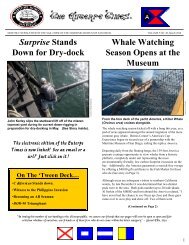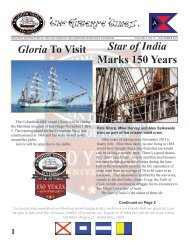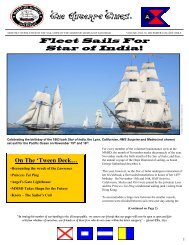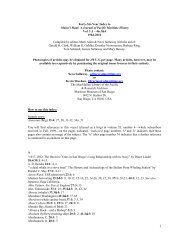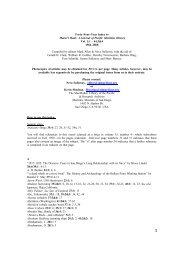Juan RodrÃguez Cabrillo And The Building Of The San Salvador
Juan RodrÃguez Cabrillo And The Building Of The San Salvador
Juan RodrÃguez Cabrillo And The Building Of The San Salvador
Create successful ePaper yourself
Turn your PDF publications into a flip-book with our unique Google optimized e-Paper software.
<strong>Cabrillo</strong>’s ships entered the Bay of Ensenada, Baja California, on 17<br />
September 1542. <strong>The</strong> expedition remained in port five days and then<br />
continued on, covering from fifteen to twenty miles daily. Within three days<br />
they sighted the three Coronado Islands, called by <strong>Cabrillo</strong> Las Islas Desiertas<br />
(Deserted Islands) and placed at 34 degrees latitude (about 2 degrees too far<br />
north). From these waters the Spanish seamen noticed the smoke of coastal<br />
Indian fires and, as they approached the mainland, saw a promising green<br />
valley backed by high mountains. On 28 September 1542, the feast day of <strong>San</strong><br />
Miguel, <strong>Cabrillo</strong> headed the <strong>San</strong> <strong>Salvador</strong> and La Victoria into <strong>San</strong> Diego Bay,<br />
dropped anchor on the lee side of Point Loma, and formally discovered Alta<br />
(Upper) California – as distinguished from Baja (Lower) California. 38<br />
<strong>Cabrillo</strong>’s <strong>San</strong> Miguel<br />
<strong>The</strong> Spaniards stepped ashore and were greeted by friendly Indians<br />
whom <strong>Cabrillo</strong> described as “well built” and clothed in animal skins.<br />
<strong>The</strong> admiral bestowed the name of <strong>San</strong> Miguel Arcángel (St. Michael<br />
Archangel) upon his newly discovered “closed and very good port,” but it<br />
was changed sixty years later by Sebastián Vizcaíno, the Spanish navigator<br />
who chose to honor <strong>San</strong> Diego de Alcalá instead. Canonized as St. Didacus<br />
in 1588, Franciscan Brother Diego’s name had become popular in naming<br />
ships, forts, and ports during the early seventeenth century. Vizcaíno entered<br />
the bay in his flagship <strong>San</strong> Diego on 12 November 1602, the feast day of <strong>San</strong><br />
Diego de Alcalá. 39<br />
Three Indians timidly approached <strong>Cabrillo</strong>’s ship, indicating by signs<br />
that they knew of other similarly dressed white men, carrying crossbows<br />
and swords, traveling far inland. <strong>Cabrillo</strong> understood from their gestures<br />
that these strangers (probably a detachment from Coronado’s expedition)<br />
wielded lances from horseback and had killed many Indians. For this reason<br />
the California natives were afraid, but the Spaniards gave them presents and<br />
calmed their fears. When Indians wounded three seamen on a night fishing<br />
party near the shore, <strong>Cabrillo</strong> ordered his crew not to fire on them but to win<br />
their confidence. Spain’s first visitors to <strong>San</strong> Diego, called “Guacamal” by<br />
the natives, set a precedent of friendly treatment that was followed with few<br />
exceptions during the entire Spanish occupation of the territory. 40<br />
Sailing from <strong>San</strong> Diego after six days’ rest, the expedition sighted the<br />
Channel Islands of <strong>San</strong> Clemente and <strong>San</strong>ta Catalina. Since the harbor at <strong>San</strong><br />
Miguel had inadvertently been given the name of the smallest ship in the fleet,<br />
these two islands were named La Victoria and <strong>San</strong> <strong>Salvador</strong>, after the other<br />
two ships.<br />
<strong>Of</strong>f Catalina the Spaniards saw numerous Indians dancing and shouting on<br />
the shore, making signs for them to land and sending a canoe to approach the<br />
ships. When the sailors went ashore, some of the women ran away, though<br />
they quickly returned. After this, as the report has it, “<strong>The</strong>y felt very secure,<br />
the Spaniards, the Indian women, and everyone. 41 Though <strong>Cabrillo</strong> named the<br />
Island <strong>San</strong> <strong>Salvador</strong> and took formal possession in the name of the king, the<br />
47<br />
men of the fleet called the place Isla Capitana or <strong>Juan</strong> Rodríguez. 42<br />
S a n S a l v a d o r



